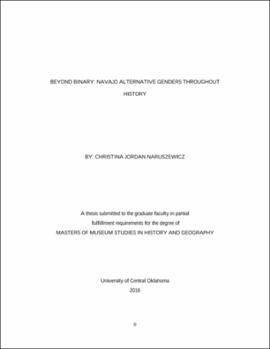| dc.contributor.advisor | Churchill, Lindsey Blake | |
| dc.contributor.author | Naruszewicz, Christina J. | |
| dc.date.accessioned | 2020-07-09T14:41:38Z | |
| dc.date.available | 2020-07-09T14:41:38Z | |
| dc.date.issued | 2016 | |
| dc.identifier.other | (AlmaMMSId)9982456883002196 | |
| dc.identifier.uri | https://hdl.handle.net/11244/325130 | |
| dc.description.abstract | Hosteen Klah was both a Navajo medicine man and weaver. However, the Navajo largely considered weaving to be a woman’s task. Women taught this skill from mother to daughter, and it represented both a creative and spiritual outlet. On the other hand, the realm of medicine men largely employed men. To become a medicine man in the Navajo tribe took years of practice and memorization. Hosteen Klah participated in both of these spheres due to his unique status as a nadleehi. In the eyes of his tribe, Klah stood neither as a man, or a woman, but as a balance of the two. Klah blended his knowledges of these two spheres to help create a new style of Navajo weaving called the sandpainting textile. However, Klah’s new style caused an uproar on the reservation because he broke major taboos by incorporating sacred sandpainting images into his weavings. My thesis explores the role of Klah’s art in reflection of centuries of outside or colonial influences. I hypothesized that an exploration of Klah’s weaving may indicate more about the nadleehi role and its perception within the Navajo community. To best understand this I needed a grasp of political, economic, and social histories of the tribe. The first chapter opens up with a review of the literature and research on relevant topics. Chapters two and three examine the influences on traditional gender roles and customs under both Spanish and American colonialization. Chapters three and four examine more intimately gender roles and the gendered activities within the Navajo tribe. In the final chapter I examine Klah’s motivations and work. | |
| dc.rights | All rights reserved by the author, who has granted UCO Chambers Library the non-exclusive right to share this material in its online repositories. Contact UCO Chambers Library's Digital Initiatives Working Group at diwg@uco.edu for the permission policy on the use, reproduction or distribution of this material. | |
| dc.subject.lcsh | Navajo Indians | |
| dc.subject.lcsh | Two-spirit people | |
| dc.subject.lcsh | Sex role | |
| dc.subject.lcsh | Navajo textile fabrics | |
| dc.subject.lcsh | Sandpaintings | |
| dc.subject.lcsh | Navajo male weavers | |
| dc.subject.lcsh | Navajo Indians | |
| dc.subject.lcsh | Two-spirit people | |
| dc.subject.lcsh | Sex role | |
| dc.subject.lcsh | Navajo textile fabrics | |
| dc.subject.lcsh | Sandpaintings | |
| dc.subject.lcsh | Navajo male weavers | |
| dc.title | Beyond binary : Navajo alternative genders throughout history. | |
| dc.type | Academic theses | |
| dc.contributor.committeeMember | Loughlin, Patricia | |
| dc.contributor.committeeMember | Lacher, Katrina | |
| dc.thesis.degree | M.A., Museum Studies | |
| dc.subject.keywords | Native American studies | |
| dc.subject.keywords | American history | |
| dc.subject.keywords | Gender studies | |
| dc.subject.keywords | Berdache | |
| dc.subject.keywords | Hosteen Klah | |
| dc.subject.keywords | Navajo | |
| dc.subject.keywords | Two-Spirit | |
| dc.identifier.oclc | (OCoLC)ocn953527861 | |
| uco.group | UCO - Graduate Works and Theses::UCO - Theses | |
| thesis.degree.grantor | Jackson College of Graduate Studies. | |
